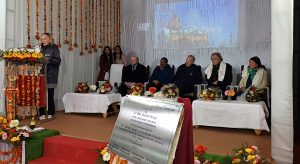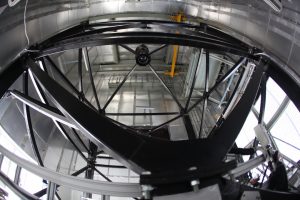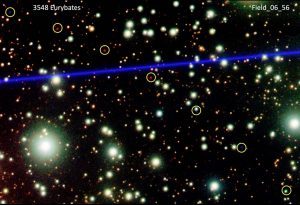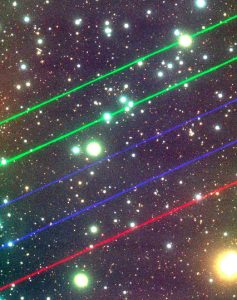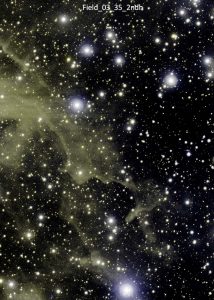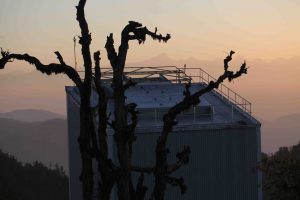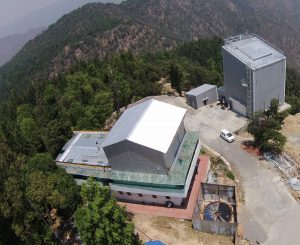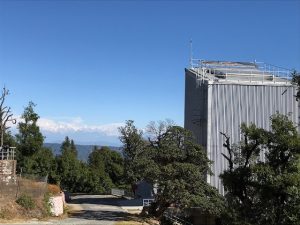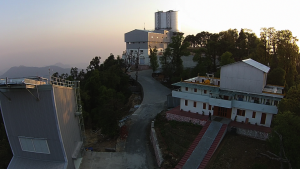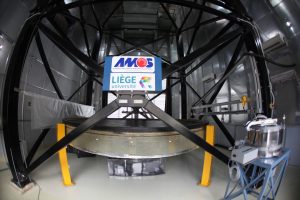Aryabhatta Research Institute of Observational sciences (ARIES) Manora Peak, Nainital
India now has a world-class 4-m optical telescope at Devasthal in Uttarakhand which achieved its first light on 29 April 2022.
The telescope is ready to explore the deep celestial sky. It is indeed with great pride that ARIES announces the inauguration of the 4-m International Liquid Mirror Telescope (ILMT) on March 21st 2023 by the Honourable Minister of State for Science & Technology and Earth Sciences, Government of India, Dr. Jitendra Singh, in the gracious presence of the Honourable Governor of Uttarakhand Lt. Gen (Retd.) Gurmeet Singh, and Belgian and Indian dignitaries at Devasthal.
Figure 1: From left: Anne-Sophie Nyssen, Ronald Van der Linden, S. K. Varshney, Didier Vanderhasselt, Jean Surdej, Brigitte Decadt
The 4-m international liquid mirror telescope has just been inaugurated in India in the presence of Didier Vanderhasselt (Belgian Ambassador to India), Prof. Anne-Sophie Nyssen (Rector of the University of Liège) and Prof. Jean Surdej (Principal Investigator of the 4-m ILMT project, University of Liège). Were also present: Brigitte Decadt and Laurent Ghys (BELSPO), Synhaeve Timothy and Guillaume de Bassompierre (Embassy of Belgium), Xavier Verians (AMOS), Dr Ronald Van der Linden (Director of ROB) and Dr Peter De Cat (ROB and Belgian organizer of BINA). There were about 250 participants among which some 35 Belgian ones.
Figure 2: Bottom to top view of the 4-m International Liquid Mirror Telescope. The dedicated optical corrector is well seen at the top of this picture.
The ILMT employs a 4-metre-diameter rotating mirror made up of a thin layer of liquid mercury, to collect and focus light. The metal mercury is in liquid form at room temperature and at the same time highly reflective. Hence, it is ideally suited to form such a mirror. The ILMT is designed to survey the strip of the sky passing overhead each night, allowing it to detect transient or variable celestial objects such as supernovae, gravitational lenses, space debris, asteroids, etc.
There are primarily three components in a liquid mirror telescope: i) A bowl containing a reflecting liquid metal (essentially mercury), ii) an air bearing (or motor) on which the liquid mirror sits, and iii) a drive system. Liquid mirror telescopes take advantage of the fact that the surface of a rotating liquid naturally takes on a parabolic shape, which is ideal for focusing light. A scientific grade thin transparent film of mylar protects the mercury from air friction that could induce ripples over the mercury surface. The reflected light passes through a sophisticated multi-lens optical corrector that produces sharp images over a wide field of view.
A 4k ⨯ 4k CCD camera, located above the mirror at the focus, records 22 arcminute wide strips of the sky.
Figure 3: A colour composite photograph of a small portion of the sky observed with the ILMT through the g, r and i Sloan filters. Seven positions of the asteroid 3548 Eurybates are seen on this picture. The blue streak is due to a passing space debris.
The ILMT is the first liquid mirror telescope designed exclusively for astronomical observations. This is the largest aperture telescope available in the country at present and is also the first optical survey telescope in India. While scanning the strip of the sky every night, the telescope generates nearly 10-15 Gigabytes of data. The wealth of ILMT generated data will permit the application of Big Data and Artificial Intelligence/Machine Learning (AI/ML) algorithms that will be implemented for classifying the objects observed with the ILMT. The data will be analysed quickly to discover and discern variable and transient stellar sources. The 3.6 – m DOT, with the availability of sophisticated back-end instruments, will allow rapid follow-up observations of the newly-detected transient sources with the adjacent ILMT.
Figure 4: A colour composite photograph of a small portion of the sky observed with the ILMT through the g, r and i Sloan filters. Streaks caused by Meridian 3 (37212), an old Russian satellite (ILMT, October 2022).
The data collected from the ILMT, over an operational time of 5 years, will be ideally suited to perform a deep photometric and astrometric variability survey. Multi spectral band observations have been obtained with the ILMT during the first commissioning phase of the telescope in October-November 2022. It has provided a treasure of data. Precise astrometric and photometric calibration of the data has been accomplished and hundreds of known asteroids, nebulae, planetary nebulae, distant galaxies, stellar clusters have already been identified (see the figures presented hereafter). The photometric follow up of a supernova that has recently been identified is going on. There is no doubt that the ILMT constitutes a unique survey instrument that will lead soon to new discoveries.
The ILMT collaboration includes researchers from ARIES in India, the University of Liège and the Royal Observatory of Belgium in Belgium, the University of British Columbia, Laval University, the University of Montreal, the University of Toronto, York University and the University of Victoria in Canada, the Ulugh Beg Astronomical Institute of the Uzbek Academy of Sciences and National University of Uzbekistan in Uzbekistan.
Figure 5: A colour composite photograph of a small portion of the sky observed with the ILMT through the g, r and i Sloan filters. A nice nebula is seen on this picture. It represents the ashes of a dead star.
The telescope was designed and built by the Advanced Mechanical and Optical Systems (AMOS) Corporation and the Centre Spatial de Liège in Belgium. The principal investigator of the project is Prof. Jean Surdej (Liège University, Belgium). Since the beginning of the ILMT project, Prof. Paul Hickson (UBC) has been acting as the project manager. The astronomer in charge at ARIES is Dr Kuntal Misra.

